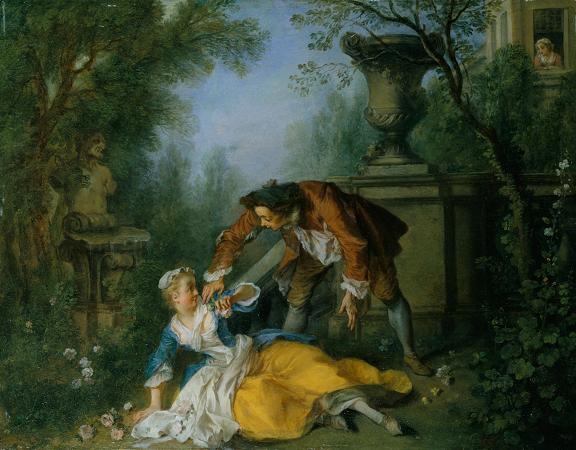Antoine Watteau (1684 - 1721). Jean-Antoine Watteau, commonly referred to as Antoine Watteau, was a French painter whose brief career spurred the revival of interest in colour and movement, as seen in the tradition of Correggio and Rubens. He revitalized the waning Baroque style, shifting it to the less severe, more naturalistic, less formally classical, Rococo. Watteau is credited with inventing the genre of fête galantes, scenes of bucolic and idyllic charm, suffused with a theatrical air. Some of his best known subjects were drawn from the world of Italian comedy and ballet. Watteau was born in October 1684 in the town of Valenciennes which had recently passed from the Spanish Netherlands to France. His father, Jean-Philippe Watteau, was a roofer given to brawling. Showing an early interest in painting, Jean-Antoine may have been apprenticed to Jacques-Albert Gérin, a local painter. Jean-Antoine's first artistic subjects were charlatans selling quack remedies on the streets of Valenciennes. Watteau left for Paris in 1702. There he found employment in a workshop at Pont Notre-Dame, making copies of popular genre paintings in the Flemish and Dutch tradition; it was in that period that he developed his characteristic sketchlike technique. By 1705 he was employed as an assistant by the painter Claude Gillot, whose work represented a reaction against the turgid official art of Louis XIV's reign. In Gillot's studio Watteau became acquainted with the characters of the commedia dell'arte, a favorite subject of Gillot's that would become one of Watteau's lifelong passions. Afterward he moved to the workshop of Claude Audran III, an interior decorator, under whose influence he began to make drawings admired for their consummate elegance. Audran was the curator of the Palais du Luxembourg, where Watteau was able to see the magnificent series of canvases painted by Peter Paul Rubens for Queen Marie de Medici. The Flemish painter would become one of his major influences, together with the Venetian masters he would later study in the collection of his patron and friend, the banker Pierre Crozat. In 1709, Watteau tried to obtain a one-year stay in Rome by winning the Prix de Rome from the Academy, but managed only to get awarded with the second prize. In 1712 he tried again and was considered so good that, rather than receiving the one-year stay in Rome for which he had applied, he was accepted as a full member of the Academy. He took five years to deliver the required reception piece, but it was one of his masterpieces: the Pilgrimage to Cythera, also called the Embarkation for Cythera. Watteau lacked aristocratic patrons; his buyers were bourgeois such as bankers and dealers. Among his most famous paintings, beside the two versions of the Pilgrimage to Cythera, one in the Louvre, the other in the Schloss Charlottenburg, Berlin, are Pierrot, Fêtes venitiennes, Love in the Italian Theater, Love in the French Theater, Voulez-vous triompher des belles? and Mezzetin. The subject of his hallmark painting, Pierrot, is an actor in a white satin costume who stands isolated from his four companions, staring ahead with an enigmatic expression on his face. Watteau's final masterpiece, the Shop-sign of Gersaint, exits the pastoral forest locale for a mundane urban set of encounters. Painted at Watteau's own insistence, in eight days, working only in the mornings. in order to warm up his fingers, this sign for the shop in Paris of the paintings dealer Edme François Gersaint is effectively the final curtain of Watteau's theatre. It has been compared with Las Meninas as a meditation on art and illusion. The scene is an art gallery where the façade has magically vanished, and the gallery and street in the canvas are fused into one contiguous drama. Watteau alarmed his friends by a carelessness about his future and financial security, as if foreseeing he would not live for long. In fact he had been sickly and physically fragile since childhood. In 1720, he travelled to London, England, to consult Dr. Richard Mead, one of the most fashionable physicians of his time and an admirer of Watteau's work. However, London's damp and smoky air offset any benefits of Dr. Mead's wholesome food and medicines. Watteau returned to France and spent his last few months on the estate of his patron, Abbé Haranger, where he died in 1721, perhaps from tuberculous laryngitis, at the age of 36. The Abbé said Watteau was semi-conscious and mute during his final days, clutching a paint brush and painting imaginary paintings in the air. His nephew, Louis Joseph Watteau, son of Antoine's brother Noël Joseph Watteau, and grand nephew, François-Louis-Joseph Watteau, son of Louis, followed Antoine into painting.
more...














